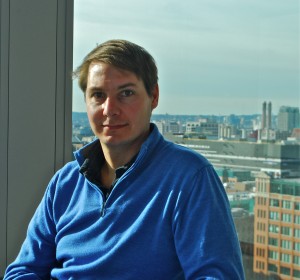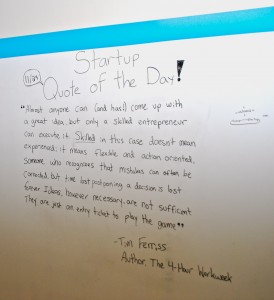 Although the MassChallenge Startup Competition has come and gone, I’ve had the pleasure of writing about several of the prize-winning companies including: Ksplice, Relay Rides, 3PlayMedia, Osmopure, Storage by Mail, and Locately. As 2010 comes to a close, MassChallenge is already putting the wheels in motion for the next competition for 2011. With tremendous anticipation for next years event I sat down with John Harthorne, CEO of Mass Challenge for a 3 part series to: tell the story about how Mass Challenge was formed, lessons learned from 2010, and what we can expect the next MassChallenge to look like in 2011.
Although the MassChallenge Startup Competition has come and gone, I’ve had the pleasure of writing about several of the prize-winning companies including: Ksplice, Relay Rides, 3PlayMedia, Osmopure, Storage by Mail, and Locately. As 2010 comes to a close, MassChallenge is already putting the wheels in motion for the next competition for 2011. With tremendous anticipation for next years event I sat down with John Harthorne, CEO of Mass Challenge for a 3 part series to: tell the story about how Mass Challenge was formed, lessons learned from 2010, and what we can expect the next MassChallenge to look like in 2011.
In 2007 after graduating from MIT Sloan, John Harthorne wanted to launch the next billion-dollar tech startup. After creating, then tossing business plan after business plan, he realized that none of his ideas were going to be compelling enough to get funding. Lacking that big-money idea, Harthorne decided to return to Bain & Company where he had worked in the previous summer as a strategy consultant. It was at that moment, when he sat down at his desk that he met his future co-founder, Akhil Nigam. The two realized they shared a passion for startups and began working together on generating business plans. However, as December 2008 approached, the economy took a turn for the worst, and talks of the next “Great Depression” loomed.
Although the two had stability at Bain their plan and desire was to leave and do a startup. “We used three different ways to brainstorm ideas,” said Harthorne. “The first is to find a gap in the market that makes people unhappy. At the time, the problem clearly was jobs, growth, economic stability and optimism. The second way we thought about it was follow the money. Even in a crappy economy somebody is spending money on something. Along that train of thought President Obama had just passed a stimulus plan of over $700 billion to create jobs, economic stability, etc. But again, I don’t have a bag of jobs…so still don’t have a solution to that problem. The third way we looked at it was how could you re-purpose your previous experience?” While at Sloan Harthorne ran a Global Startup Workshop, which is a conference on how to use competitions to promote entrepreneurial activity. From that experience he had gathered hundreds of contacts from trying to get speakers to speak the Global Startup Workshop.
With all this in mind, Harthorne pondered, “how can I use that…how can I tap into that network? I literally didn’t come up with it, and it’s painful to me in hindsight because it was so glaringly obvious. I literally went to bed and had one of those Eureka moments. I was half-asleep and I woke up and said ‘wait a minute…the world needs a competition!’”

A competition is an accelerator, it will catalyze activity, and that’s exactly what we need. The government is so desperate to try to create and promote jobs, and there’s this huge pile of money available that they aren’t even going to be able to spend in such a short period of time!” The original carnation of the idea for Harthorne and Nigam at that moment was to somehow get through to President Obama’s people. With Obama’s strong grassroots campaign they believed they could navigate their way through his network and find someone of authority to connect with.
“When we find the right person the idea would be to setup a $50 million fund that would take equity stakes,” said Harthone. “Here the government is pouring money into GM and they were buying equity. So if they can do that, why not do the same thing for startups? Putting money into GM, you’re going to stem the bleeding, but you aren’t going to create a single new job. The idea was we would run a competition with the federal government’s backing, prominence, and exposure that would literally attract hundreds of thousands of applications from all over the world. We’d then sift through it, and announce the winners that would receive cash grants. The government would then say as part of this that they would take 49% stake in these companies. This investment would subsequently act like a promotion to other investors in order to reduce the risk. The government wouldn’t take a management roll, they would just piggy-back on the outside investors, and exit out of the company at the next financing round.”
One of the first places Harthorne and Nigam turned for funding was the state of Massachusetts. When they first met with Secretary Greg Bialecki, he said, “I love it. I want you guys to do this, what do you need?” The two explained they had a lot of people supporting the idea, and even had letters of support from 15 of the top innovators of the state including Desh Deshpande, presidents of MIT, Tufts, Northeastern, UMASS and many other top lawyers and investors. There was a ton of support but nobody wants to write the first check because those dollars would be the most at risk. So Greg’s response was, “how much do you need?” Harthorne explained that they needed about $350K for the planning stages to which he responded, “You know, we’re laying off firemen and teachers…so it’s not really a good time to be writing big checks for a brand new idea. What’s the minimum I could give you that would be helpful?” Harthorne thought for a minute and said “$100K.” Without skipping a beat Secretary Bialecki replied, “Done, give me 30 days.” Harthorne regales, “people complain that the government is slow moving, but Secretary Bialecki called us up 27 days later and said, ‘we got your money, we’re going to announce it on Tuesday. You ready?’ We then went back to all the investors and explained that the governor was going to put in $100K; we used your letters of support to get that…are you now willing to step up? They lined up and each said yes, yes, yes.”
Toward the end of June, Harthorne and Nigam made their first announcement of grant money including the $100K from the state of Massachusetts, $100K from Desh Deshpande, $75K from Microsoft, and $50K from the Kauffman Foundation. Their original plan was to revolutionize the world of venture capital with a for-profit model with a fund that had better deal sourcing than any other fund. However, in order for this system to work well you have to have significant scale. They needed people, office space, lawyers, advisers, and nobody would be willing to donate any of those resources if they realized they were making a profit off the back end. “We realized in order to do it as a for-profit it would probably not work,” explains Harthrone. “We thought to ourselves, ‘you know what, we didn’t originally launch this idea to make a ton of money…we did this because we love startups and want to be involved in startups.’ It was more important to us that it was large and successful, so we turned into a non-profit. We now could be totally committed to the community, startups, and creating jobs and growth.”
Their original plan was to revolutionize the world of venture capital with a for-profit model with a fund that had better deal sourcing than any other fund. However, in order for this system to work well you have to have significant scale. They needed people, office space, lawyers, advisers, and nobody would be willing to donate any of those resources if they realized they were making a profit off the back end. “We realized in order to do it as a for-profit it would probably not work,” explains Harthrone. “We thought to ourselves, ‘you know what, we didn’t originally launch this idea to make a ton of money…we did this because we love startups and want to be involved in startups.’ It was more important to us that it was large and successful, so we turned into a non-profit. We now could be totally committed to the community, startups, and creating jobs and growth.”
Tune in next week for part two of this three part series on MassChallenge.
